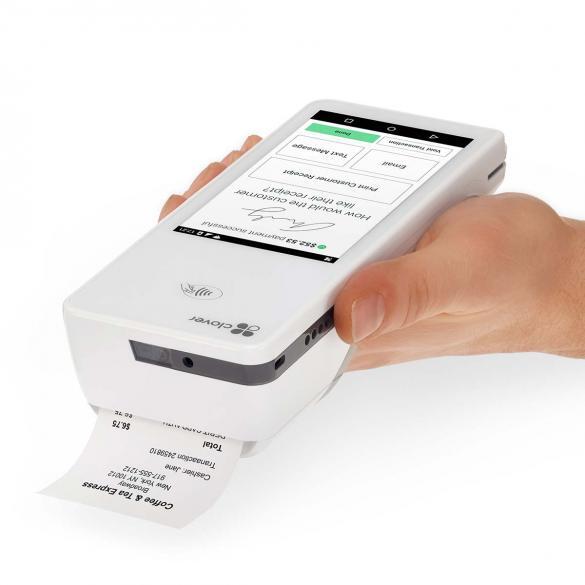Understanding Clover Flex – Paper Compatibility

If you run a business that uses the Clover Flex, you already know it’s built for speed and mobility. But even the most efficient tools can fail when you don’t use the right supplies.
One of the most overlooked is receipt paper. It may seem like a small detail, but using incompatible paper can lead to big problems like unclear prints, printer jams, or even device damage.
Choosing the right thermal paper keeps your operations smooth. It protects your equipment, improves the customer experience, and saves time in the long run.
This guide shows you exactly what to look for and why it matters.
What is the Clover Flex?
Clover Flex is a handheld point-of-sale (POS) terminal. You can take payments, print receipts, and scan barcodes from one device. It runs on Wi-Fi or LTE, making it perfect for mobile businesses or service staff on the move.
You might use it at a salon, retail counter, or restaurant. The built-in printer uses heat to print, which means no ink or toner is needed, just thermal paper. That’s where compatibility becomes critical. If the paper isn’t right, nothing else works properly.
Why Paper Compatibility Matters
Thermal printers are picky. They’re designed to work with particular paper types and sizes. Using paper that’s too wide, too long, or not thermal at all can quickly cause problems.
You could end up with blurry or unreadable prints, constant jams that slow service, worn-down printer parts from forced feeding, or customer complaints due to faded or missing information.
Using the correct paper helps your device run longer with fewer issues. It also gives you consistent, clean receipts every time.
Recommended Paper Specifications for Clover Flex

Optimal Paper Size
For best results, you need:
- Width: 2 1/4 inches (57mm)
- Length: 50 feet (15.24 meters)
- Core Size: 0.5 inches (12.7mm)
- Paper Type: Thermal only
Why These Specifications Are Ideal
This size is designed for the Clover Flex printer compartment. It feeds cleanly, doesn’t curl or jam, and uses every inch efficiently. Longer rolls might not fit, and shorter rolls need constant changing.
The 2 1/4" width ensures the text aligns and prints correctly without cutting off. Thermal paper is required because Clover Flex uses heat to print. Ink-based or bond paper will not work. Stick to the exact specs, and your device will stay reliable.
Features to Look for in Compatible Thermal Paper

Not all thermal paper is equal. Here's what you should check for:
- BPA-Free and Phenol-Free: These chemicals are often found in thermal paper. While legal, they’re linked to health concerns. Many businesses now prefer paperless systems, especially in the food service and healthcare industries.
- High Brightness: Brighter paper improves print clarity. Dark ink stands out, making receipts easier to read. This helps during returns, customer inquiries, or audits.
- End-of-Roll Indicator: A red stripe near the end of the roll lets your team know it’s time to replace it. This avoids mid-transaction rollouts and keeps service flowing.
- Durability: Look for paper that resists smudging, moisture, and fading. Customers often hold on to receipts for weeks, but poor-quality paper won’t last that long.
Top Thermal Paper Options for Clover Flex at Paper Planet
Paper Planet offers thermal paper rolls explicitly made for Clover Flex. Here are two recommended options:
Clover Flex Thermal Printer Paper Rolls
Paper Planet offers thermal paper rolls designed explicitly for the Clover Flex POS system. These rolls are BPA-free and compatible with Clover Flex models C400, C401, and C405. They are engineered to provide smudge-free printing and include a low paper warning mark.
30 Phenol-Free Thermal Rolls
Paper Planet's Phenol-Free Thermal Rolls are produced without Bisphenol A (BPA) or S (BPS), making them completely BPA-Free and BPS-Free. These rolls are recyclable and fully compliant with California’s Prop 65 regulations, offering an eco-conscious option for businesses.
Proper Storage and Handling of Thermal Paper
Even a good paper will fail if stored poorly. Heat and moisture break down thermal coatings, making prints light or spotty.
To prevent this:
- Store in a cool, dry place
- Avoid direct sunlight or extreme heat
- Keep away from oils, cleaning products, or other chemicals
- Always handle rolls with clean hands
Storing paper properly ensures that your receipts will always come out clean, even if the roll has been sitting for a few weeks.
Common Issues from Using Incompatible Paper
Here’s what happens if you don’t use the right paper:
- Text comes out light or patchy
- The printer jams mid-transaction
- Rolls don’t fit or feed correctly
- The print head wears down faster
- Repairs and replacements increase operating costs
This can be avoided using appropriately sized thermal paper designed for your device.
Conclusion
Don’t cut corners with your receipt paper using Clover Flex. The right thermal paper keeps your system running without hiccups.
It protects your printer, improves customer experience, and helps your business avoid downtime. Stick with 2 1/4" x 50' thermal paper rolls.
Ensure they’re BPA-free, feed smoothly, and come from a trusted supplier. Paper Planet offers tested options that meet every need. One small decision, choosing the right paper, makes a big difference.
Frequently Asked Questions
Can I use any thermal paper with Clover Flex?
No. It must be 2 1/4" wide, 50 feet long, with a 0.5" core, and designed for thermal printers. Other sizes or types will not feed properly or may damage the machine.
What happens if I use the wrong paper size?
It can cause feeding issues, misalignment, and unreadable receipts. Some papers may jam or fit too loosely in the compartment.
Is BPA-free paper necessary?
It’s not required but highly recommended. BPA-free and phenol-free options reduce health concerns and are better suited for industries where customer safety is a priority.
How long does a 50' roll last?
Usually, around 50 to 70 receipts, depending on the length of each transaction printout. High-volume businesses may go through multiple rolls per day.

